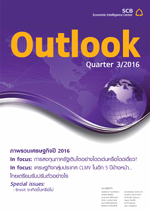Outlook Quarter 3/2016
EIC revised the forecast of Thailand’s economic growth in 2016 to 2.8%, up from 2.5% previously due to higher-than-expected economic growth in the first quarter and tourism sector that is likely to record exceptional growth throughout the year. Positive surprises in economic growth in the first quarter came from government consumption spending that grew much higher than expected due to accelerated purchases of goods and services, as well as better-than-anticipated increase in the number of foreign visitors. Moreover, private investment, especially construction activities, received a boost from the rush to meet government’s real estate stimulus deadline and from government transfers through village funds for investments. However, EIC views that unexpected growth in 1Q16 was due largely to temporary factors. Growth for the rest of the year may be slower, given that expenditures have already been frontloaded and some support measures have already been expired. While other positive signs of recovery are still unclear, the tourism sector is likely to be the economy’s bright spot for yet another year.
 |
Economic Outlook in 2016 Global Economy in 2016 Brexit, will it happen? Thai Economy in 2016: Keep an eye on government measures Bull - Bear: Oil Prices In focus: Public Investment - Leader without Followers? In focus: CLMV economies, 5 years down the road: Summary of main forecasts |
|
Global Economy in 2016
In 2016, the global economy will grow at a gradual pace. EIC sees a lower risk of a global recession thanks to declining risks of China’s hard landing and better economic recoveries in the major economies such as Eurozone, and Japan in the first quarter. However, the global economy still faces major obstacles from slow recoveries in the manufacturing sector in many countries, putting pressures on global trade and commodity prices. In the second half of 2016, major economies like the U.S. and Eurozone will rely on growth in domestic demand driven by steady labor market improvements. The Japanese economy still needs to rely on additional economic stimulus measures through both monetary and fiscal policies even though it expanded well in the first quarter as its recovery is still fragile. As for China, the growth slowdown has stabilized and signs are better than expected. However, the rebalancing of the Chinese domestic economy continues to weigh on global trade. Its impact can be substantial for export-reliant countries.
Another key risk factor for the global economy is volatility in the financial market that comes from the monetary policy of major economies. Japan tends to rely on monetary policy in stimulating its economy as growth remains weak and deflation risks are prevalent. In addition, the U.S. Federal Reserve is likely to raise interest rates this year. These two policies have contributed to higher volatility risks as the direction of capital flows has become more sensitive to changes in monetary policy of these central banks.
Bull - Bear: Oil Prices
EIC’s view: BEAR
Crude oil prices in the third quarter of 2016 remain low due to the excess supply of around 1 million per day. The excess supply comes from higher production and exports from the OPEC, especially Iran after the lifting of sanctions. Saudi Arabia’s policy appears to retain its market share. However, the declining oil rigs in the US reflect that the US oil production tends to slow down, relieving some pressures on the supply. Moreover, we must now watch for political tensions within the OPEC that may push the prices up in the short term.
In focus: Public Investment - Leader without Followers?
Public investment was a leader of the Thai economy. It paved the way for many subsequent economic activities and induced many followers to invest which in turn helped the economy growing faster. However, the role of public investment in leading Thailand’s economic development and attracting private investment has gradually subsided. The unprecedented surge in public investment last year went unmatched by the private sector, as private investment shrunk for the third consecutive year. What is a possible explanation for this phenomenon? And while the Thai economy is facing difficulties in achieving its potential growth, how can public investment come back to lead the economy and private investment as in the past?
In focus: CLMV economies, 5 years down the road: how will Thailand embrace the opportunities?
Public investment was a leader of the Thai economy. It paved the way for many subsequent economic activities and induced many followers to invest which in turn helped the economy growing faster. However, the role of public investment in leading Thailand’s economic development and attracting private investment has gradually subsided. The unprecedented surge in public investment last year went unmatched by the private sector, as private investment shrunk for the third consecutive year. What is a possible explanation for this phenomenon? And while the Thai economy is facing difficulties in achieving its potential growth, how can public investment come back to lead the economy and private investment as in the past?